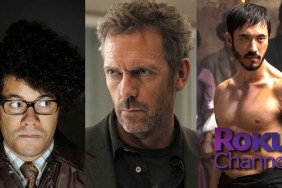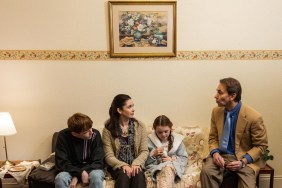
SHOCK looks back at a landmark of controversial television terror, the BBC production of GHOSTWATCH.
The British Broadcasting Corporation (BBC) is one of the most trusted names in world news reporting. Its also known for its lavish dramatic productions of classic novels as well as violent criminal procedural shows such as THE FALL. On the night of Halloween 1992, the BBC combined all of those elements when it aired GHOSTWATCH. Hosted by real-life BBC presenters Michael Parkinson, Sarah Greene, Mike Smith and Craig Charles, GHOSTWATCH was billed as a live special investigating the potential paranormal goings-on in a residential North London house. The special took place in two locations with Parkinson and Smith hosting the proceedings from television studio while Greene and Charles were on location live with the family whose house was under investigation.
GHOSTWATCH dealt with a potentially malevolent ghost named Pipes (so named for its manifestation in the rattling pipes in the house). The camera crew enters, sets up cameras throughout the house and waits to capture something unexplained. Back in the television studio Parkinson interviews a parapsychology expert named Dr. Lin Pascoe (Gillian Bevan) who becomes increasingly concerned about the case and what occurs in the house. After a few false scares which are proven to be pranks, the evening takes a decidedly sinister turn when truly unexplained phenomenon begins to occur. The show becomes increasingly unstable as the camera crew interviews residents in near-by houses who share the houses unsettling past. With the events quickly going from bad to worse in the broadcast, GHOSTWATCH takes an unexpected and terrifying turn followed by an abrupt ending.

If the viewers had paid attention the credits of the broadcast it would have become apparent that the proceedings were fictional. GHOSTWATCH aired in the BBC 1 spot which at the time was called Screen One known for airing dramatic fictional programming. But like Orson Welles WAR OF THE WORLDS broadcast which elicited reactions from a terrified public who were convinced the American eastern seaboard was being overtaken by aliens, GHOSTWATCHs airing terrified the nation. Though it was aired on Halloween, its important to keep in mind that Halloween isnt the large-scale holiday that it is in North America, with the Brits favoring Guy Fawkes Night (aka Bonfire Night) over trick or treating. The British public was in a panic with calls put in to the authorities to check on the BBC studios. The BBC reported approximately 30,000 panicked calls to their studio after the show finished. Once the hoax was revealed further complaints were lodged against the network for the frightening nature of the broadcast and the suicide of 18 year old Martin Denham was blamed on the broadcast. In February 1994 the British Medical Journal reported signs of Post-Traumatic Stress Disorder in two young boys who had watched the program. Following the initial broadcast and subsequent complaints and allegations, the BBC banned GHOSTWATCH for a decade adding to the mythos of the supposedly haunted program. As the internet age took hold in the late 1990s, tales of the terrifying television show persisted and GHOSTWATCH was eventually release on DVD in 2002 by the British Film Institute.
GHOSTWATCH was written by Stephen Volk (who went on to write the ghost-ridden 2011 film The Awakening) and directed by Lesley Manning a veteran of British television which allows GHOSTWATCH to occupy a rarefied space where it shares similarities with and functions as a precursor to the found footage horror trend. GHOSTWATCH, however, also functions as an invasive look at the safety of the viewers home, literally turning the medium into a message. The dramatic turn of events at the climax of GHOSTWATCH directly involves the viewing audience who are implied to have had a hand in the proceedings, essentially accusing them of having a hand in what they have just viewed and caused. This turn goes further than found footage horror films, in particular PARANORMAL ACTIVITY hich shares many commonalities with GHOSTWATCH but is essentially about the private sphere rather than the public sphere. GHOSTWATCH is effective because it plays out like a television news broadcast blurring the lines between public and private. Found footage horror films are, in essence, footage the public was never meant to see which creates an enticing means through which an audience can spy and enter into the private and personal moments of fictional characters. GHOSTWATCH was meant to be seen by a large audience; in fact the conceit is predicated on that. By using trusted BBC television presenters to dupe the audience, GHOSTWATCH felt trustworthy. These presenters were invited into the viewers homes nightly to provide news and commentary. Watching them effectively satirize the news media felt as though the show had gone too far.

Looking back at GHOSTWATCH, its still a highly effective and chilling watch especially for fans of ghost stories. Though partially based on the Enfield poltergeist case (which is also the basis for THE CONJURING 2) GHOSTWATCH plays up its opening mundaneness, the sheer normal-ness of it all. The primary host of GHOSTWATCH Michael Parkinson even says to the camera as the events begin to build, We dont want to give anybody sleepless nights. Up until the very end, GHOSTWATCH attempts to maintain its veil of keep calm and dont mind the ghosts.
GHOSTWATCH has become a sort of cult artifact in popular culture; it remains an anomaly precisely because of how effective it was. It managed to not only terrify but to actually traumatize its viewers. The backlash against it was so loud and forceful that it seems to have scared off any true imitators. It exists outside of televisions specials such as Foxs ALIEN AUTOPSY which always felt like a tawdry affair (despite Jonathan Frakes participation). GHOSTWATCH worked, arguably too well, because of its reliance on the real – the real presenters purporting to present facts aired on one of the most trusted names in media. GHOSTWATCH proved that sometimes even fiction can be too real.









